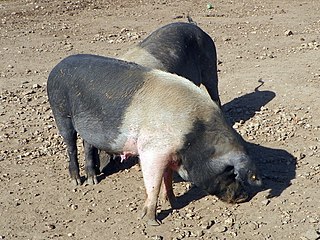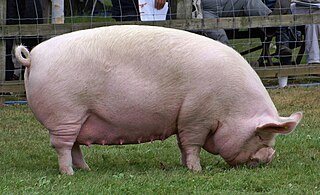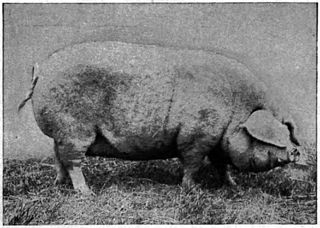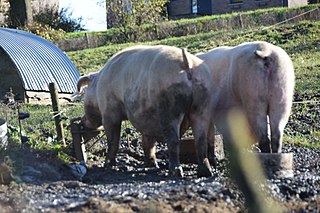Related Research Articles

In animal husbandry or animal fancy, a breed standard is a description of the characteristics of a hypothetical or ideal example of a breed. The description may include physical or morphological detail, genetic criteria, or criteria of athletic or productive performance. It may also describe faults or deficiencies that would disqualify an animal from registration or from reproduction. The hypothetical ideal example may be called a "breed type".

The Morab is an American breed of horse originally developed through the cross-breeding of Arabian and Morgan horses. The breeding of Morab horses began in the late 1880s with the intent of creating a fine carriage horse that was still substantial enough for moderate farm labor.

German Black Pied cattle are a breed of dairy cattle that originated in the North Sea coast regions of northern Germany and the Netherlands.

The Tux-Zillertal, German: Tux-Zillertaler, is an endangered Austrian breed of domestic cattle. It was created in 1982 when two similar Alpine breeds, the Tux and the Zillertal, were merged. The two names derive from those of the municipality of Tux in the Tuxertal, and of the neighbouring Zillertal, both in the Tirol region of Austria. The Tux-Zillertal may derive from the Swiss Hérens breed. Like the Hérens, it was long selected for the fighting ability of the cows, at the expense of productive characteristics.

The Berkshire is a British breed of pig. It originated in the English county of Berkshire, for which it is named. It is normally black, with some white on the snout, on the lower legs, and on the tip of the tail.

The Anglo-Nubian is a British breed of domestic goat. It originated in the nineteenth century from cross-breeding between native British goats and a mixed population of large lop-eared goats imported from India, the Middle East and North Africa. It is characterised by large, pendulous ears and a convex profile. It has been exported to many parts of the world, and is found in more than sixty countries. In many of them it is known simply as the Nubian.
The Semirechensk is a Kazakh breed of domestic pig. It was purpose-bred in the twentieth century in the Kazakh Soviet Socialist Republic of the Soviet Union. The breeding stock was principally Large White, with some admixture of Siberian Kemerovo and a small proportion of wild boar.
The Aksai Black Pied is a distinctively black and white spotted pig breed from Kazakhstan.

The Poland China is an American breed of domestic pig. It was first bred in Warren County in Ohio, in the American Midwest. Its origins lie in a small number of pigs of Chinese type bought in 1816, which were cross-bred with a variety of breeds of European origin including the Berkshire. It was bred as a lard pig, and is among the largest of all pig breeds.

The British Saddleback is a modern British breed of domestic pig. It was created in 1967 by merging the surviving populations of two traditional saddleback breeds, the Essex and Wessex Saddleback.

The Dutch Landrace is a traditional Dutch breed of domestic goat. It has been known in the Netherlands since the seventeenth century, and was formerly numerous there. It came close to extinction in the 1950s, but was saved by cross-breeding with unrelated goats, and by 2020 numbered over 2000 head.

The Middle White is a British breed of domestic pig. It originated in Yorkshire, and derived from the Large White and the now-extinct Small White. It was recognised in 1852, and the first herd-book was published in 1884. It is a porker, reared for fresh pork, and is characterised by a short and sharply-upturned snout. After the Second World War it came close to extinction; although numbers have recovered somewhat, it is listed by the Rare Breeds Survival Trust as "priority" – the highest level of risk.

The Italian Landrace is an Italian breed of domestic pig. It derives from the Danish Landrace breed developed in Denmark at the end of the nineteenth century. Stock was imported into Italy after the Second World War. The breed has been selected principally for suitability for the production of prosciutto crudo. It is, after the Large White Italiana, the second-most numerous pig breed in Italy. The breed standard is issued by the Ministero delle Politiche Agricole Alimentari e Forestali, the Italian ministry of agriculture and forestry; the herdbook is kept by the Associazione Nazionale Allevatori Suini, the national pig-breeders' association.

The Lincolnshire Curly Coat or Lincolnshire Curly-coated, also known as the Baston Pig, is an extinct British breed of domestic pig. It originated in, and was named for, the county of Lincolnshire, in the East Midlands. Like many other traditional pig breeds, it became rare after the Second World War. By 1970, it had disappeared. An older, still existing breed of similar looking pigs is the Hungarian Mangalica.

The Husum Red Pied is a rare breed of domestic pig with the nickname Danish Protest pig. It originates from North Frisia in Southern Schleswig in the beginning of the 20th century, when Danes living in the area under Prussian rule were prohibited from raising the Danish flag and displayed the Protest Pig instead. Due to its red color, its broad white vertical belt, and a trace of a white horizontal belt resembling the colors of the flag of Denmark, it was made a symbol of their cultural identity.

The Beijing Black, also known as the Peking Black, is a breed of domestic pig from China. They are mostly black, but have some white markings. The breed was created in 1962 by cross-breeding a Berkshire with a common Chinese pig. Two other breeds, the Soviet White and the Yorkshire, were also crossbred with native Chinese pigs. It is described as being a "strong, rugged breed" that has "good production traits".

The Belarus Black Pied, also known as the Byelorussian Black Pied, the White-Russian Black Pied, and the Spotted Black Pied, is a breed of domestic pig from Belarus. It was originally crossbred in Minsk in the late 19th century from the breeding of Large White, Large Black, Berkshire, and Middle White pigs with native Belarus pigs. The Belarus Black Pied wasn't recognized as a separate breed group until 1957 and not as an individual breed until 1976.
The Ba Xuyen is a breed of domestic pig from South Vietnam, specifically the Mekong Delta. It is a spotted black and white pig with white feet. It was bred from a cross between a Berkshire and a Boxu from 1932 to 1956.

The Belgian Landrace, also known as the Improved Belgian, Belgian Improved Landrace, and the Belgian Lop-eared, is a breed of domestic pig from northern Belgium. It was created from importing English breeds and improving them until they were "graded up" to the German Improved Landrace from 1930 to 1945 and then breeding them with the Dutch Landrace in 1945. Other breeds were also incorporated into the bloodline to strengthen it, such as with ones from Luxembourg in 1955, Germany in 1971, and the Czech Republic in 1974. Used in many different countries, the Belgian Landrace is also one of the "four major commercial breeds" in France.
The Large White Ulster, or Ulster White, was a breed of domestic pig. Primarily bred for bacon production, it was the favoured breed of farmers in the north of Ireland up until the mid 20th century.
References
- ↑ Porter, Valerie; Mason, Ian Lauder (2002). Mason's world dictionary of livestock breeds, types, and varieties. CAB International. p. 216. ISBN 9780851994307 . Retrieved November 16, 2011.
- ↑ Porter, Valerie (1993). Pigs: a handbook to the breeds of the world. Comstock Pub. Associates. p. 156. ISBN 9780801429200 . Retrieved November 16, 2011.
- ↑ "Pork and Bacon". Bulgaria Today. Sofia Press Agency. 11: 45. 1962. Retrieved November 16, 2011.